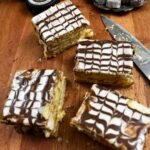Mille-Feuille (French Napoleon Dessert)
Layer upon layer of golden puff pastry is expertly baked to perfection, creating a crisp and light base that harmonizes with the luscious filling.
Servings 4 People
Calories 683kcal
Equipment
- 1 Rectangular Mille-Feuille Baking Pan
Ingredients
- 1 Puff Pastry The foundation of the Napoleon pastry is made from layers of flaky puff pastry. This delicate pastry dough is made by folding butter into a basic dough, creating distinct layers that puff up when baked. While store-bought puff pastry is readily available, making your own from scratch will elevate the taste and texture of your Napoleon pastry.
- 1 Pastry Cream The creamy filling is an essential component of the Napoleon pastry. Pastry cream, also known as crème pâtissière, is made by combining milk, eggs, sugar, and cornstarch. The mixture is heated until thickened, resulting in a velvety smooth custard-like cream. Traditional Napoleon pastries often feature a vanilla-flavored pastry cream, but you can experiment with different flavors such as chocolate, coffee, or fruit-infused variations.
- 1 Powdered Sugar A dusting of powdered sugar on top of the Napoleon pastry adds a touch of sweetness and elegance. It not only enhances the visual appeal of the pastry but also provides a delicate contrast to therich flavors of the puff pastry and cream.
Instructions
- Preheat the oven to 400°F (200°C) and line a baking sheet with parchment paper. Roll out the puff pastry on a lightly floured surface into a rectangle, approximately ¼ inch thick. Trim the edges to create clean, even sides.
- Transfer the rolled-out puff pastry onto the prepared baking sheet and prick it with a fork to prevent excessive puffing during baking.
- Cover the puff pastry with another sheet of parchment paper and place a second baking sheet on top to weigh it down. This ensures that the pastry bakes evenly and stays flat.
- Bake the puff pastry in the preheated oven for 15-20 minutes or until it turns golden brown and crispy. Remove from the oven and let it cool completely.
- While the puff pastry is cooling, prepare the pastry cream. In a saucepan, heat the milk over medium heat until it reaches a gentle simmer.
- In a separate bowl, whisk together the eggs, sugar, and cornstarch until well combined.
- Slowly pour the hot milk into the egg mixture,whisking constantly to prevent curdling. Return the mixture to the saucepan and cook over medium heat, stirring constantly, until it thickens into a custard-like consistency.
- Remove the pastry cream from the heat and stir in the vanilla extract. Place a piece of plastic wrap directly on the surface of the pastry cream to prevent a skin from forming. Let it cool completely.
- Once the puff pastry and pastry cream are cooled, it's time to assemble the Napoleon pastry. Cut the puff pastry into equal-sized rectangles.
- Place one layer of puff pastry on a serving plate and spread a generous amount of pastry cream on top. Repeat this process, alternating layers of puff pastry and pastry cream, until you've used all the ingredients. Finish with a layer of puff pastry on top.
- Dust the assembled Napoleon pastry with powdered sugar using a fine sieve. You can also use a piping bag to create decorative patterns on top.
- Refrigerate the Napoleon pastry for at least 2 hours to allow the flavors to meld together and the pastry cream to set.
- Once chilled, slice the Napoleon pastry into individual portions and serve. Enjoy the delicate layers and creamy filling that make this dessert a true masterpiece.
Notes
Tips for Achieving a Perfect Napoleon Pastry
Creating a perfect Napoleon pastry requires attention to detail and a few handy tips. Here are some tips to help you achieve the best results:- Use cold butter when making the puff pastry dough. Cold butter creates distinct layers and helps the pastry puff up during baking.
- Chill the puff pastry before baking. This helps the layers of butter solidify, resulting in a flakier and more delicate texture.
- When rolling out the puff pastry, make sure it's of even thickness throughout. This ensures that the pastry bakes evenly and avoids any undercooked or overcooked sections.
- Prick the puff pastry with a fork before baking to release any trapped air and prevent excessive puffing.
- When making the pastry cream, be sure to whisk constantly to avoid lumps and curdling. If lumps do form, you can strain the mixture through a fine-mesh sieve to remove them.
- Allow the puff pastry and pastry cream to cool completely before assembling the Napoleon pastry. This prevents the cream from melting and compromising the structure of the pastry.
- Refrigerate the assembled Napoleon pastry for at least 2 hours before serving. This allows the flavors to meld together and the pastry cream to set properly.
Nutrition
Calories: 683kcal | Carbohydrates: 57g | Protein: 9g | Fat: 47g | Saturated Fat: 12g | Potassium: 75mg | Fiber: 2g | Calcium: 12mg | Iron: 3mg
